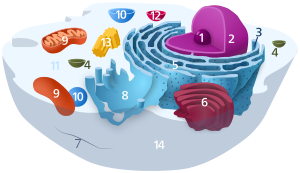Organelles
| Organelle | |
|---|---|
| Details | |
| Identifiers | |
| Latin | organella |
| Code | TH H1.00.01.0.00009 |
| TH | H1.00.01.0.00009 |
| FMA | 63832 |
|
Anatomical terminology
[]
|
|
| Cell biology | |
|---|---|
| The animal cell | |

Components of a typical animal cell:
|
In cell biology, an organelle (/ɔːrɡəˈnɛl/) is a specialized subunit within a cell that has a specific function. Individual organelles are usually separately enclosed within their own lipid bilayers.
The name organelle comes from the idea that these structures are to cells what an organ is to the body (hence the name organelle, the suffix -elle being a diminutive). Organelles are identified by microscopy, and can also be purified by cell fractionation. There are many types of organelles, particularly in eukaryotic cells. While prokaryotes do not possess organelles per se, some do contain protein-based bacterial microcompartments, which are thought to act as primitive organelles.
In biology organs are defined as confined functional units within an organism. The analogy of bodily organs to microscopic cellular substructures is obvious, as from even early works, authors of respective textbooks rarely elaborate on the distinction between the two.
Credited as the first to use a diminutive of organ (i.e., little organ) for cellular structures was German zoologist Karl August Möbius (1884), who used the term organula (plural of organulum, the diminutive of Latin organum). In a footnote, which was published as a correction in the next issue of the journal, he justified his suggestion to call organs of unicellular organisms "organella" since they are only differently formed parts of one cell, in contrast to multicellular organs of multicellular organisms.
...
Wikipedia
